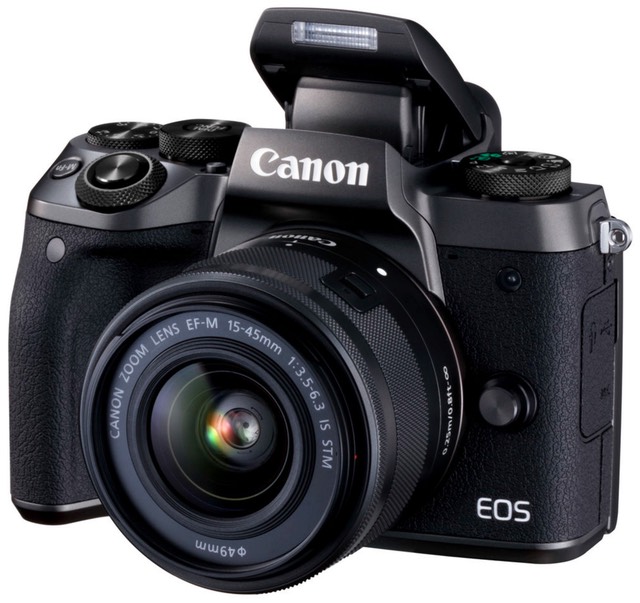
What is It?
The Canon EOS M5 is finally a fully interesting mirrorless camera from one of the DSLR duopolists.
Previously, Canon seemed to be low-balling their mirrorless M models, shooting for some sort of entry user with low expectations of direct camera control and somewhat low focus and other performance expectations. The M5, on the other hand, seems like a really well designed small Rebel DSLR, and shares quite a lot of DNA with the Canon DSLRs.
This change in design approach has completely turned around the M lineup. Whereas before we had only soapbar-type designs you held at arms' length, now we've got a small at-the-face camera that feels like it was designed for that. (There's also now an M6 model that basically reinstates the soap-bar, arms' length design, but with almost all the other M5 additions/changes.)
Canon seems to have standardized much of their lower lineup now on the 24mp dual-pixel APS-C sensor (1.6x crop). That sensor appears in everything from the EOS M5 to the EOS 80D now, meaning that the level of image quality and live view/video focus performance you can expect from the entire lower end of the Canon ILC lineup is now much the same, whether mirrorless camera or crop sensor DSLR. And that sensor is quite good at both image quality and focus (more on that in the performance section, below).
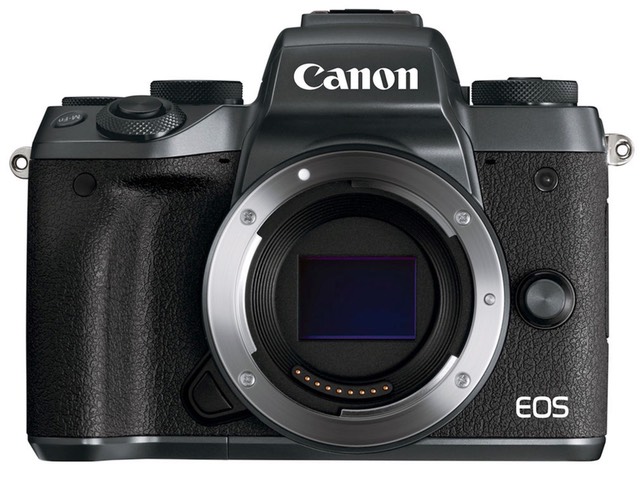
Coupled with the new 24mp sensor and its smart dual-pixel, on-sensor phase detect focus design, the M5 adds a 2.36m dot OLED electronic viewfinder, a 3.2" and 1.6m dot tilting rear touchscreen, plus multiple direct control dials and buttons.
Up top alone we have a Mode dial, an exposure compensation dial, a front control dial, and a multi-function dial. If anything, the M5 seems to have a bit more customization and direct control than the bottom end Rebels, which is definitely a large step in the right direction.
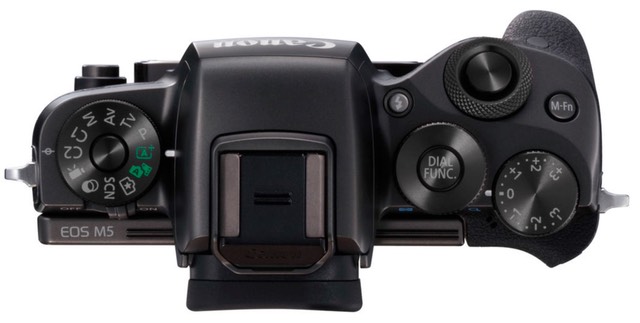
ISO runs from 100-25600 on the M5, just as on the DSLRs with the same sensor. But Auto ISO is simplified, only allowing you to set the maximum ISO value. The camera has a tendency to pick too slow a shutter speed for many situations in Auto ISO, rendering that function mostly useless.
The overall design works out very much like a small DSLR, including a viewfinder hump in the center top that also contains a hot shoe and a small pop-up flash (GN 5m at ISO 100). The right side of the camera features a deep hand grip on the front—at least for this sized camera—and a very pronounced thumb-hold hump positioned on the rear. Again, DSLR-like, though small DSLR.
The M5 will shoot short bursts at 7 fps with full focus and metering, 9 fps with focus and metering locked to the first shot.
The dual-pixel focus system has a few wrinkles to it, including the ability to use EF and EF-S adapted lenses, but the best of these wrinkles is that ability to use the touchscreen for focus positioning while shooting (turned on and off by the Touch & Drag AF Settings menu item). This works better than expected with the eye at the viewfinder, as the EVF juts back from the camera enough to let you get your thumb over onto the rear LCD while shooting. You can control whether the whole or part of the LCD is active for this.
Like the low-end EOS DSLRs, the shutter in the M5 only goes to 1/4000, and the flash sync maxes out at 1/200.
As you might expect, there's built-in Wi-Fi (802.11/b/g/n) with both LE Bluetooth and NFC for ease of connecting. You can use a standard Canon wired remote, a wireless remote, or your smartphone to control the camera. USB is the now slow 2.0 type.
Probably the one aspect of the M5 that disappoints the Canon faithful is the video capabilities. While Canon supports a 5-axis electronic image stabilization (due to a bit of an additional crop when in video mode), the maximum video capability is 1080P/60, and that maxes out at a 35Mbps bit rate with an H.264 type encoding. The camera has a stereo microphone built in as well as a remote mic input, but no headphone monitoring. A micro-HDMI port is built into the right side of the camera.
The EOS M5 uses the common LP-E17 battery pack, though the rated shot life is only 295 (CIPA).
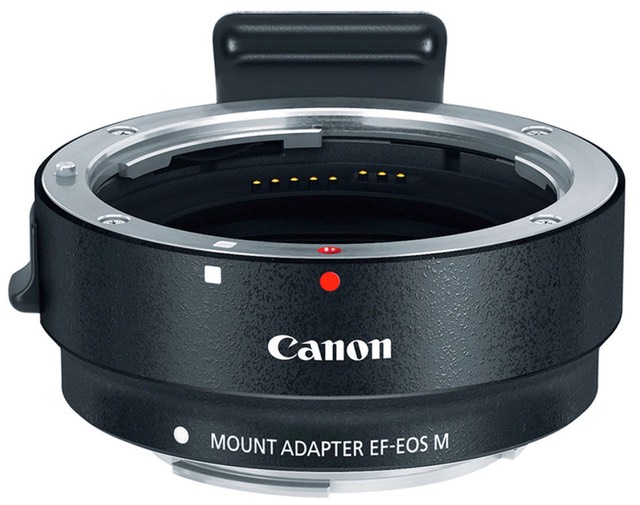
If you have Canon EF or EF-S lenses, you can use them on the M5 with the Canon EF-EOS M Adapter, an overly expensive (US$199) tube that mostly just passes through electrical contacts. I tried a few such lenses on the camera, and they pretty much perform the way they do on the Canon DSLRs in the Live View mode. Which is to say pretty good, given the recent dual-pixel upgrade to all the Canon DSLRs for Live View, but certainly not at DSLR-levels when it comes to very long lenses and distant, fast moving subjects.
The camera body itself is mid-weight at 15 ounces (427g), but small at 4.5 x 3.5 x 2.4" (116 x 89 x 61mm).
The camera is made in Japan.
Source of the review unit: purchased from dealer stock.
How's it Handle?
In a word, like a DSLR. The twin command dials coupled with the dedicated exposure compensation dial give you quick access to setting the camera. Unlike most exposure compensation dials, the M5's tends to stay put due to the slight ridge that extends behind it at the back of the camera; it's not easily dislodged.
Add in the Dial Func combo, which repurposes one of those command dials with the press of its center button, and you find that you have control of almost everything you'd like right in convenient DSLR-like controls.
Well, sort of. The default for the Dial Func button/dial is only to set ISO or WB. If you want that dial to do more than that, get ready for one of the most convoluted setting options I've ever seen. I couldn't figure it out from just trial and error. Eventually I pulled up the manual, and it too isn't exactly straightforward, as it immediately leads you from the Dial Func section to the "Configuring Custom Functions" section where you'll fall down some engineer's version of a rabbit hole. Why Dial Func Customization isn't just a menu option I have no idea. The engineer in charge probably ate the blue pill.
Likewise, setting up back button focus wasn't exactly obvious, either. The good news is that there is plenty of customization you can do to at least four assignable buttons and the dials. The bad news is that you'll need a three-hour study hall before hand to figure out how to do it.
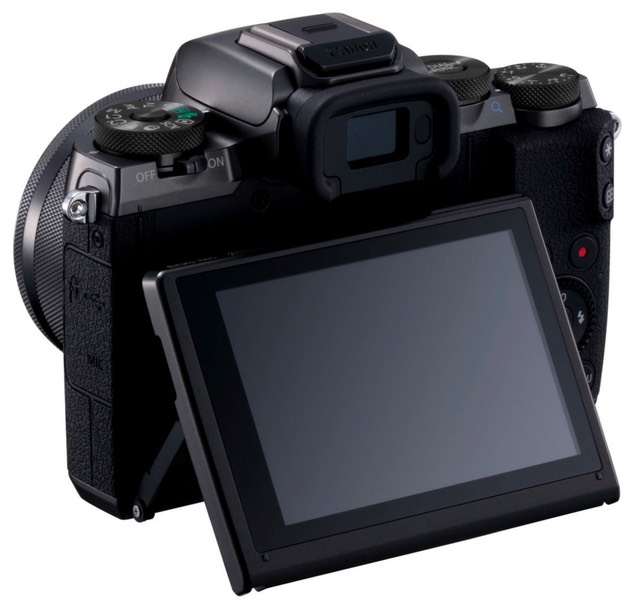
The touchscreen on the M5 is one of the things that sets it apart from a low-end DSLR, as it turns out. As I noted, you can slide your thumb on the rear LCD when shooting in order to control where the focus is made, and this even works in Face Detect mode: if the camera detects multiple faces you can slide your finger to the one you want it to use.
You also get use of the touchscreen in menus, in the quick setting mode, and even for tap-and-shoot if you're not using the EVF.
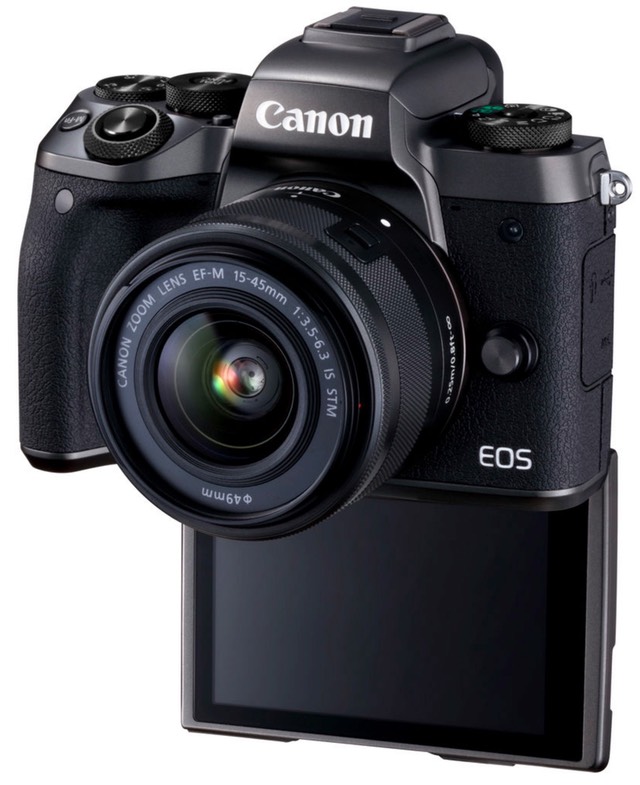
One thing I don't like is the "selfie tilt" for the rear LCD. Many cameras do the 180° flip upwards. But that jutting EVF and the viewfinder hump prohibit that, so the M5 flips to the bottom. That's a problem for anything other than a stripped camera, handheld. With even a small Arca-style plate on the bottom of the camera, the screen won't get to 180°, and of course on a tripod flipping down is not going to work.
Another thing I don't understand why camera makers keep doing is the "respond from temporary sleep" issue: you have to press the shutter release part way to reactivate the M5. No other button will activate the camera from sleep. Moreover, this reactivation is somewhat slow.
Finally, once again we have a still camera maker putting the record video button in the wrong place. My thumb just naturally falls to the spot where that button is located way too easily. I can't count how many inadvertent videos I shot in the course of using this camera for still images. I've peppered videos all over my cards, it appears. And it's annoying to pick up the camera and try to shoot only to note the big red REC staring at you. There's not a single time I can think of where I wanted so spontaneous a video that having the button right under my thumb proved useful.
How's it Perform?
Battery life: As you might expect, on the poor side. I actually was getting more than the 295 shots per battery charge that Canon indicates with much of my shooting, but I was shooting bursts and not using flash and a few other features that suck battery. When I just used the camera for some random travel photography and popped up the flash a few times, sure enough, 300 shots per charge was stretching it.
There are some features in the M5 that allow you to extend battery life: you can put the display in Eco mode (dims after two seconds of inactivity), for instance. But these are band-aids on the bigger problem (too small a battery for a serious consumer of energy).
Most of us mirrorless users have by now figured out that we need a small handful of batteries and a dual-battery charger (e.g. the Watson models at B&H) to keep our frustration with our cameras from boiling over. The M5 is no different: I wouldn't head out for a full day of shooting without three or four batteries. I'd probably fully use at least two of them. At least that's been the early pattern.
Write Speed/Buffer: One thing to note is that the EVF doesn't keep up with 7/9 fps bursts: you get the dreaded "last image slide show" effect. But assuming you can deal with that, you can get almost 20 images into the buffer before, gulp, the camera loses responsiveness. Strangely, you can restart shooting as soon as buffer space is available, but you can't play back an image or use the menus if the camera is still writing to the card. Buffer unload seemed reasonably fast for a small camera: my UHS-3 card was completely clearing a full buffer of raw files in under 9 seconds. A more likely card you'd use, a SanDisk Extreme UHS-I, cleared the buffer in a bit over 11 seconds. In both cases, as soon as at least one image is freed up, the camera can continue shooting. So basically you drop from 7 fps to a bit more than 1 fps at buffer fill.
Autofocus: The dual-pixel design first appeared on the Canon 70D. With the new 24mp APS-C sensor we've now got it in two mirrorless and three DSLR cameras using basically the same technology. Note that the dual-pixels don't cover the entire sensor. They cover about three-quarters the width and two-thirds the height. Overall, they are active over about two-thirds the sensor.
This restriction has to do with the fact that each of the pixel pairs only look at half the lens. So obviously as you near one edge of the sensor, one of the pair will be looking outside the aperture area and not seeing anything.
That said, I don't find the restriction problematic at all. Most of the time I want to focus in the middle two-thirds anyway, so there isn't an issue. And I don't really need tracking focus performance at the edge ever.
I've seen tests where people say that the M5 is just as good as a DSLR. I wouldn't put it quite that far. I was impressed at how well the M5 managed to track fast, random moving animals. The results weren't always dead perfect on the eyes, but I actually found that the Canon tracking was doing slightly better than the Sony tracking in the same situation. The Sony would beat the Canon in absolute first acquisition speed, but not necessarily in focus accuracy if the subject was moving. Compared to earlier Canon EOS M models, this is a huge step forward. The M5 is now competitive with quite a few of the players on the market, particularly if you've started it tracking by half pressing before release. Maybe not the best of the best, but good enough that it can hold its own even in tough situations.
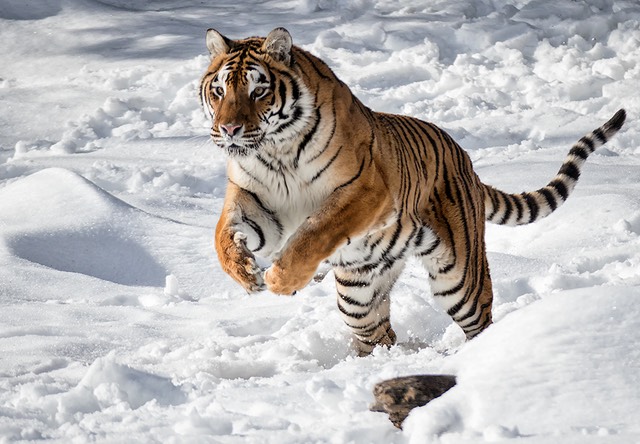
With a little practice, I was able to get the M5 with the 55-200mm lens tracking the Siberian at full speed. The ability to move the focus point with my thumb on the LCD certainly helped with this.
Face detect works great on humans, not so much on animals. Don't laugh. Some of the face detect systems I've tried are surprisingly good with animal and bird faces. But not the Canon. It needs more than two eyes and a mouth, apparently.

Here's an image taken before I had mastered the thumb on LCD cursor move: the camera kept up with tracking, but fairly centered on the frame. In other words, the camera was keeping up with fast moving animals, it really was only the position of the focus area that stopped it from nailing everything. That's fine by me, as it's just practice-makes-perfect. It's the non-repeatable and non-predictable results of some earlier mirrorless systems that were fully frustrating for people coming from DSLRs. The M5 is DSLR-like: predictable and repeatable, but its overall performance is going to depend a bit on your settings and your mastery of keeping the focus area where you want it.
Image Quality: simple answer: the EOS M5 results look like Canon DSLR results. At least a crop-sensor Canon DSLR. That should be obvious since Canon is using the same basic image pipeline in the EOS M5 as they use in the Rebels and models up through the 80D.
Here's the thing: the Sony A6300 and the Canon EOS M5 live in about the same space for me: small, competent APS-C sensor mirrorless models. The Sony had been my small carry mirrorless camera, but the M5's DSLR-like style and controls trump anything that the Sony might do better: I can set up and treat the M5 like a mini-Rebel and not think about anything other than the shots I'm taking.
Comparing against my Sony A6300, which has what's considered essentially a state-of-the-art APS sensor, I found little difference to write about between it and the EOS M5. Indeed, I saw more differences in lens quality impacting the final image than in the sensor. The lowest end M lens, probably the 15-45mm f/3.5-6.3, has some clear chromatic aberration and other issues, though at low levels. The lens I was using with the Sony had better corrections.

Here's a great example of dynamic range testing: the gold at the top in the sun is right at maximum capture and some of it I've left at 255. This pushed the bar area at the bottom deeply into shadow, so much so that you can't resolve detail in that area without post processing.. Here I've run ACR to bring up those shadows, and this has produced an acceptable result. With the Sony sensors, I can get a bit more out of the shadow areas in the same situation, but ironically, have a harder time retaining the highlight detail separated well.
Still, some observations are possible: the Canon can't be pulled up quite as dramatically from underexposure as the Sony. Whereas you can easily pull up +5EV on the Sony if you absolutely have to (with the noise impact you'd expect from that), the Canon seems to be a bit more restrictive before things fall apart. Maybe +4EV.
In out-of-camera JPEGs up through about ISO 6400 there's really not much to separate the two: both the Sony and the Canon are just on the edge of producing clear color noise. Sony's algorithms tend to pull out more detail, while Canon's seem to try to hide the noise more and have a clear anti-aliasing blur at those higher ISO values. Canon's colors seem a little more accurate, the Sony's a little more hue shifted.
In raw files, most of these differences simply go away, especially with some delicate post processing choices. The Canon results seem to be easy to dial in color with the Adobe converters, as one would expect from the color model Adobe uses. But getting the color noise subdued at high ISO values while retaining edges and details was a bit more difficult for me to do at ISO 6400 than on the Sony results. A bit.
I note that dpreview claims that the M5 is "behind the competition by around one stop" in terms of raw results in their review. I'm not sure where they came up with that number, and I would challenge it. There's definitely a difference in the low level data from the Sony and the Canon. But it is not that the Canon raw at ISO 1600 looks like the Sony raw at ISO 3200. Far from that, actually. The actual difference is far less than a stop.
Final Notes
The EOS M5 is a nice little camera. No doubts about it. It's like somebody shrunk the Rebel DSLR. Much of what you might like about the Canon DSLRs is replicated in the M5, only on a scale small enough that the basic kit fits in most of my vest and jacket pockets (definitely so if you use one of the pancake lenses).
The real issue now that Canon has produced such a nice mirrorless camera is the lens set. The new 15-45mm f/3.5-6.3 kit lens is okay in that it gets us right at the 24mm equivalent at the wide end, but its not a terribly strong performer. The sensor is outperforming the lens with that lens on the camera.
We don't have a lot of lenses in the M lineup yet, and some, like the 28mm f/3.5 macro, are a bit strange to be one of the first lenses in the lineup. Right now the three best lenses for the M are the 11-22mm f/4-5.6 wide angle zoom, the 22mm f/2 pancake, and the 55-200mm f/4.5-6.3. The older 18-55mm f/3.5-5.6 mid-range zoom seems to have disappeared except in the remaining M3 kits on the market, and I don't think the 15-45mm was a step forward except for getting us past the 29mm equivalent mark at the wide end (18mm with 1.6x crop is 28.8mm equivalent). I haven't tried the new 18-150mm f/3.5-6.3 yet, but to me that's a lens that's big enough that it starts to spoil the whole idea of a mini-DSLR, and it doesn't give you anything particularly wide, either.
So one of the things you have to think about when you consider the EOS M5 is the lens set. I've been hammering Nikon (and Canon) in the crop sensor DSLR world for not getting their lens set right. I'd like to think that Canon realizes that they need many more options to make the EOS M5 truly enticing to potential buyers. That's especially true since they have several competitors that can point to a full lens set.
This is a tricky product management problem: the person who buys an M5 may not actually buy a full set of M lenses, or even more than one or two basic ones, but the fact that a full set is available is often one of the things that makes a person decide to get into a new mount. Right now Canon doesn't have that going for them. Fortunately, the three lenses I identified earlier are enough to get me by for the time being, but I'm clearly missing some options I want at the moment.
A number of people reading this review will get caught in the wrong weeds. They're going to try to figure out if the Sony focuses infinitesimally faster or the Fujifilm has better out of camera JPEG noise reduction or if the m4/3 models produce slightly smaller kits. Don't get caught in those weeds. The M5 performs just fine. It's not the fastest, the best at low light, or the smallest you can get, but it's close enough on all those parameters that you should be considering it.
Canon DSLR shooters looking for a mirrorless choice produce a no-brainer: the M5 is going to be much like you're used to, produce results you're used to, and be able to use your existing lenses with the adapter. Bingo.
It's the rest of the world that is looking askance at the M5 trying to figure it out. Let me be clear: Canon took their highly competent, perhaps best-of-class, crop sensor DSLRs and made a smaller mirrorless version. Exactly what a lot of people had been asking for. The M5 isn't a perfect camera, but its blemishes are small and mostly ignorable. I'm using mine like a small DSLR. A really small DSLR with that pancake 22mm.
While I could certainly point out a few things I'd like to see addressed on the camera—that ugly and non-intuitive customization process, for example—I'm quite happy with the result that Canon ended up with. This is the first Canon salvo in the mirrorless world that fully hit the mark. The competitors should be scared, because the #1 interchangeable lens camera maker just found the target.
Now, Canon, about those lenses...
Recommended (2017, 2018)
2020: this model is out of production and no longer available new. But used copies can easily be found. Also, check out the current M6 model.